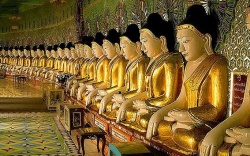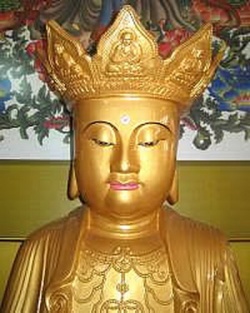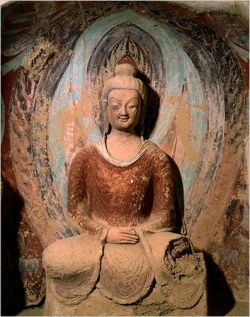Difference between revisions of "Twelve Principles of Buddhism"
m (Text replacement - "change" to "change") |
m (1 revision: Robo text replace 30 sept) |
(No difference)
| |
Revision as of 16:50, 30 September 2013
1) Self-salvation is for any man the immediate task. If a man lay wounded by a poisoned arrow he would not delay extraction by demanding details of the man who shot it or the length and make of the arrow. There will be time for ever-increasing understanding of the Teaching during the treading of the Way. Meanwhile, begin now by facing life as it is, learning always by direct and personal experience.
2) The first Fact of existence is the law of change or impermanence. All that exists, from a mole to a mountain, from a thought to an empire, passes through the same cycle of existence–i.e. birth, growth, decay and death. Life alone is continuous, ever seeking self-expression in new forms. ‘Life is a bridge; therefore build no house on it.’ Life is a process of flow, and he who clings to any form, however splendid, will suffer by resisting the flow.
3) The law of change applies equally to the ‘soul’. There is no principle in an individual which is immortal and unchanging. Only the ‘Namelessness’, the ultimate Reality, is beyond change; and all forms of life, including man, are manifestations of this Reality. No one owns the life which flows in him any more than the electric light bulb owns the current which gives it light.
4) The universe is the expression of law. All effects have causes, and man’s consciousness or character is the sum total of his previous thoughts and acts. Karma, meaning action-reaction, governs all existence, and man is the sole creator of his circumstances and his reaction to them, his future condition, and his final destiny. By right thought and action he can gradually purify his inner nature, and so by self-realization attain in time liberation from rebirth. The process covers great periods of time, involving life after life on earth, but ultimately every form of life will reach Enlightenment.
5) Life is one and indivisible: though its ever-changing forms are innumerable and perishable. There is, in truth, no death, though every form must die. From an understanding of life’s unity arises compassion, a sense of identity with the life in other forms. Compassion is described as ‘the Law of laws–eternal harmony’, and he who breaks this harmony of life will suffer accordingly and delay his own Enlightenment.
6) Life being One, the interests of the part should be those of the whole. In his ignorance man thinks he can successfully strive for his own interests, and this wrongly-directed energy of selfishness produces suffering. He learns from his suffering to reduce and finally eliminate its cause. The Buddha taught four Noble Truths: (a) The omnipresence of suffering; (b) its cause, wrongly directed desire;
(c) its cure, the removal of the cause; and (d) the Noble Eightfold Path of self-development which leads to the end of suffering.
7) The Eightfold Path consists in Right (or perfect) Views or preliminary understanding. Right Aims or Motive, Right Speech, Right Acts, Right Livelihood, Right Effort, Right Concentration or mind-development, and finally, Right Samadhi, leading to full Enlightenment. As Buddhism is a way of living, not merely a theory of life, the treading of this Path is essential to self-deliverance. ‘Cease to do evil, learn to do good, cleanse your own heart; this is the Teaching of the Buddhas.’
8) Reality is indescribable, and a God with attributes is not the final Reality. But the Buddha, a human being, became the All-Enlightened One, and the purpose of life is the attainment of Enlightenment. This state of Consciousness, Nirvana, the extinction of the limitations of self-hood, is attainable on earth. All men and all other forms of life contain the potentiality of Enlightenment; and the process therefore consists in becoming what you are. ‘Look within: thou art Buddha.’
9) From potential to actual Enlightenment there lies the Middle Way, the Eightfold Path ‘from desire to peace’, a process of self-development between the ‘opposites’, avoiding all extremes. The Buddha trod this Way to the end, and the only faith required in Buddhism is the reasonable belief that where a Guide has trodden it is worth our while to tread. The Way must be trodden by the whole man; not merely the best of him, and heart and mind must be developed equally. The Buddha was the All-Compassionate as well as the All-Enlightened One.
10) Buddhism lays great stress on the need of inward concentration and meditation, which leads in time to the development of the inner spiritual faculties. The subjective life is as important as the daily round, and periods of quietude for inner activity are essential for a balanced life. The Buddhist should at all times be ‘mindful and self-possessed’, refraining from mental and emotional attachment to ‘the passing show’. This increasingly watchful attitude to circumstances, which he knows to be his own creation. helps him to keep his reaction to it always under control.
11) The Buddha said: ‘Work out your own salvation with diligence’. Buddhism knows no authority for truth save the intuition of the individual, and that is authority for himself alone. Each man suffers the consequences of his own acts, and learns thereby, while helping his fellow men to the same deliverance; nor will prayer to the Buddha or to any God prevent an effect from following its cause. Buddhist monks are teachers and exemplars, and in no sense intermediates between Reality and the individual. The utmost tolerance is practised towards all other religions and philosophies, for no man has the right to interfere in his neighbour’s journey to the Goal.
12) Buddhism is neither pessimistic nor ‘escapist’, nor does it deny the existence of God or soul, though it places its own meaning on these terms. It is, on the contrary, a system of thought, a religion, a spiritual science and a way of life which is reasonable, practical and all-embracing. For over two thousand years it has satisfied the spiritual needs of nearly one-third of mankind. It appeals to the West because it has no dogmas, satisfies the reason and the heart alike, insists on self-reliance coupled with tolerance for other points of view, embraces science, religion, philosophy, psychology, ethics and art, and points to man alone as the creator of his present life and sole designer of his destiny.


